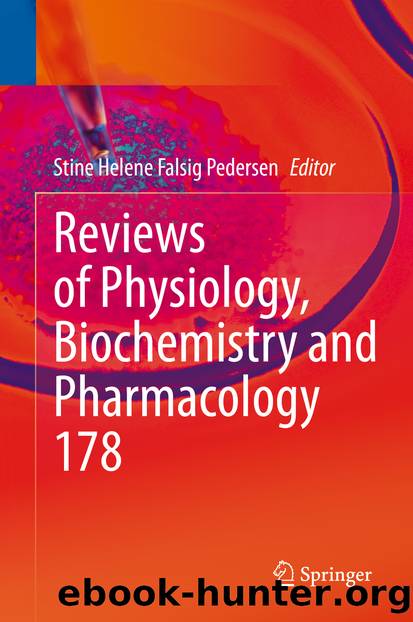Reviews of Physiology, Biochemistry and Pharmacology by Unknown

Author:Unknown
Language: eng
Format: epub
ISBN: 9783030615079
Publisher: Springer International Publishing
SLC4A11 is proposed to serve a protective function by reducing ROS production (Ogando et al. 2019). This could occur either by reducing the mitochondrial membrane potential by SLC4A11-mediated transport of H+ into the mitochondrial matrix or by transport of NH3 out of the matrix. Indeed, ROS production is reduced in glutamine-exposed cells expressing SLC4A11 in comparison to cells lacking SLC4A11 (Ogando et al. 2019). Further, supporting a link of SLC4A11 to mitochondria, HEK293 cells expressing WT SLC4A11 were less prone to accumulate ROS and to undergo apoptosis than those expressing corneal dystrophy mutants of SLC4A11 (Roy et al. 2015). Finally, in immortalized cultured human CEC, knock-down of SLC4A11 expression led to increased apoptotic cell death (Liu et al. 2012). Taken together, loss of SLC4A11 function in FECD patients increases their CEC ROS load, which may lead to an increased rate of CEC loss via cell death.
The data supporting the role of SLC4A11 in protecting against glutaminolysis-associated cell death are compelling (Ogando et al. 2019), but some caution needs to be exercised in details of the mitochondrial mechanism. Although evidence has been presented for an inner mitochondrial membrane localization for SLC4A11, none of the proteinâs splicing variants contain an N-terminal mitochondrial targeting sequence (MTS) recognized by an online analysis (Fukasawa et al. 2015). Further, full sequence analysis (Kumar et al. 2018) does not predict a mitochondrial localization for SLC4A11. Lacking a recognizable N-terminal MTS, SLC4A11 would need to target to the inner mitochondrial membrane via the mitochondrial carrier family pathway, which has been observed for carrier proteins (SLC25) with six transmembrane segments (Ogunbona and Claypool 2019). SLC4A11 with 14 transmembrane segments (Badior et al. 2017) would be extraordinarily hydrophobic to be able to reach the inner membrane. Finally, SLC4A11 does not appear in the list of 1,098 proteins present in mitochondria (Pagliarini et al. 2008), from tissues including kidney where SLC4A11 is expressed (Groeger et al. 2010). Targeting of SLC4A11 to mitochondria may be signaled by high glutamine metabolism or by a CEC-specific factor, but the reported localization of the protein to IMM will require additional study.
In addition, a role of SLC4A11 in preventing glutaminolysis-associated cell death could occur through mechanisms that do not require IMM localization. The crux of the glutaminolysis-cell death model is that mitochondrial matrix NH3 promotes ROS production. Removal of NH3 from the matrix would thus reduce ROS and reduce cell death. SLC4A11 acts as either an NH3 or NH3/H+ transporter (Loganathan et al. 2016; Zhang et al. 2015; Kao et al. 2019). Both the mitochondrial membrane potential and H+ gradient (matrix is more alkaline than cytosol) disfavor SLC4A11 transport of NH3/H+ out of the matrix. Similarly, SLC4A11 could not transport NH3/H+ out of the cell as the plasma membrane potential is negative. SLC4A11 does localize to the CEC plasma membrane, where it could facilitate NH3 efflux from the cell. In so doing, it would reduce the cytosolic NH3 concentration, which would increase the magnitude of the NH3 concentration gradient from the mitochondrial matrix to the cytosol.
Download
This site does not store any files on its server. We only index and link to content provided by other sites. Please contact the content providers to delete copyright contents if any and email us, we'll remove relevant links or contents immediately.
When Breath Becomes Air by Paul Kalanithi(7280)
Why We Sleep: Unlocking the Power of Sleep and Dreams by Matthew Walker(5668)
Paper Towns by Green John(4179)
The Immortal Life of Henrietta Lacks by Rebecca Skloot(3835)
The Sports Rules Book by Human Kinetics(3602)
Dynamic Alignment Through Imagery by Eric Franklin(3505)
ACSM's Complete Guide to Fitness & Health by ACSM(3476)
Kaplan MCAT Organic Chemistry Review: Created for MCAT 2015 (Kaplan Test Prep) by Kaplan(3431)
Introduction to Kinesiology by Shirl J. Hoffman(3308)
Livewired by David Eagleman(3140)
The River of Consciousness by Oliver Sacks(3000)
Alchemy and Alchemists by C. J. S. Thompson(2918)
The Death of the Heart by Elizabeth Bowen(2912)
Descartes' Error by Antonio Damasio(2748)
Bad Pharma by Ben Goldacre(2738)
The Gene: An Intimate History by Siddhartha Mukherjee(2502)
Kaplan MCAT Behavioral Sciences Review: Created for MCAT 2015 (Kaplan Test Prep) by Kaplan(2495)
The Fate of Rome: Climate, Disease, and the End of an Empire (The Princeton History of the Ancient World) by Kyle Harper(2444)
The Emperor of All Maladies: A Biography of Cancer by Siddhartha Mukherjee(2440)
